With the astonishingly fast growth of stand-up paddleboarding (SUP) as a sport, not only here in Sayulita but all over the world, we thought it might be a good time to do a quick run-through on some of the different types of boards and paddles out there, and what they’re good for. Sayulita is home to several world-class SUP riders, and as anyone who lives here or comes here on a visit can see, there are people paddling in our bay almost every day, locals and/or tourists, either going for speed, and/or distance, for leisure, to do yoga on the water, or sticking close to shore and riding waves. Paddleboards of all kinds can be rented from most of the surf shops as well as kiosks on the beach these days, and lessons in basic paddling as well as paddleboard surfing are offered up and down the beach.
The shapes and styles of SUP boards are still evolving, with new design twists offered up every month or so, it seems. Meanwhile, for a basic read of what’s out there, we turned to Hector “Papas” Gonzalez, Sayulita native, long time surfer, and one of the top paddleboard surfers and racers in Mexico. Papas has raced and surfed internationally, and along with Fernando Stalla, Ryan Helm, and a few others who call our pueblo home, he has made Sayulita and competitive stand-up paddling virtually synonymous. Several of Sayulita’s many great surfers have emerged, in the last two years, as those counted among Mexico’s stand-out SUP surfers.
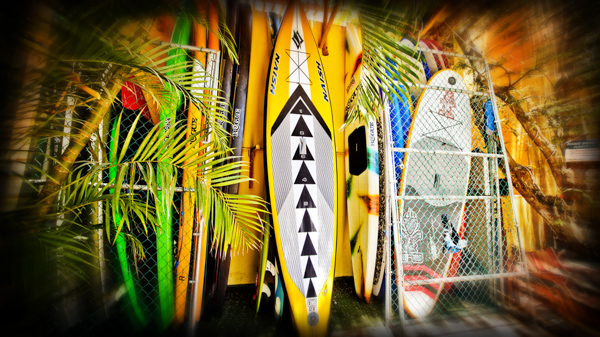
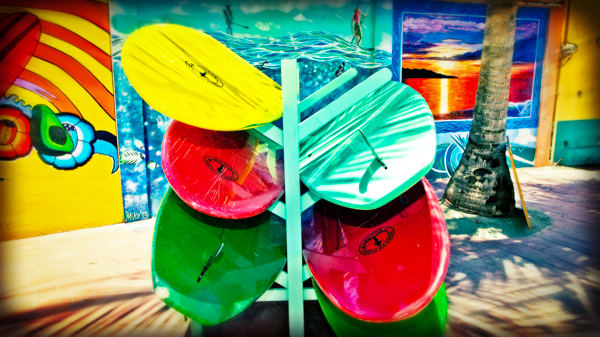
This is one of the hottest SUP towns on the planet these days, and also one of the few places, I suspect, where there is not a fundamental disagreement going on between traditional surfers and SUPpers. Here, people are comfortable switching back and forth. I know I have been accused of “going over to the dark side” by some of my surfing pals, when they see me wielding my paddle out there. To them I say, people, it’s just crossover, similar but different, another way to play in the waves. There’s nothing wrong with doing both.
However, here I must interject a personal observation: while I don’t believe SUP surfing is by nature evil relative to “regular” surfing, there is definitely an unsettling vibe when you are out there, standing on your paddleboard, looking down on all the surfers sitting on their boards around you, waiting for waves. There is, obviously, an inherently hierarchical relationship implied by “looking down” on someone, and when you are standing next to someone sitting, looking down on them, this feeling comes in to play. You are not just hanging out, out there, together, waiting for waves with the gang. There are two gangs, the standers and the sitters. You are taller, you see farther out to sea, you have an advantage. I wish it were not so, but it is unavoidable.
And what is worse is when you, experienced surfer, are looking up at a moron (sorry, I meant to say beginner) on a SUP, completely clueless in the waves, paddling like a demon from hell for the perfect wave you have chosen to ride. He has chosen to ruin it for you, because he knows how to paddle. He does not know how to surf, and he should not be SUPping in head-high waves at Burros, or La Lancha, or Sayulita. Respect the surf, and the surfers, people.
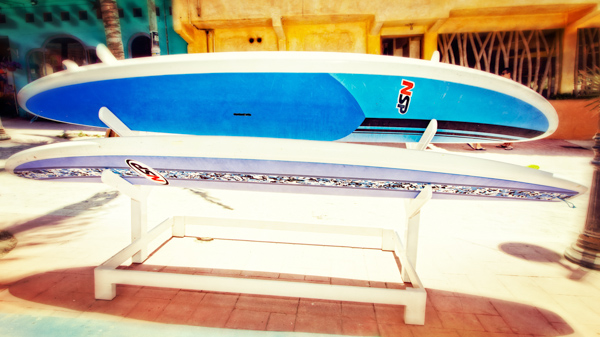
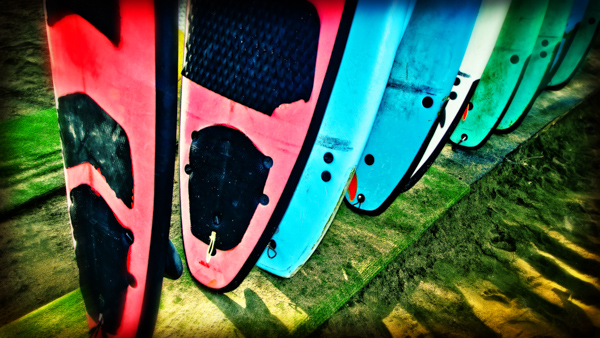
Stay humble, SUPpers. Get down there and sit with the surfers, and you will remain one of them.
Nevertheless, these days, for me, in small surf (less than head high) stand-up paddle surfing is more fun and more challenging than traditional surfing. Although there are plenty of people out there shredding big waves on their SUPs, when the waves get big, managing a fat, floaty, quad-fin paddleboard and a paddle is just too much for me.
Back to the boards. According to Papas, there are basically three types, although there is a lot of crossover between flatwater “touring” boards and boards designed for wave riding.
First, racing boards. Let’s get these freaks out of the way. These are long, 12 to 14 feet or more, narrow in width but up to six inches thick from top to bottom, with a pointed nose that is designed for cutting through chop and swell. They have flat bottoms to enhance glide and speed, but deep concave indentations on the deck for the paddler’s feet, to lower the center of gravity and thus provide greater stability. These boards are designed for high speed paddling over medium to long distances. They are not meant for wave-riding or rapid maneuvering, although most serious paddle-racers have taught themselves to ride waves on them–because when a race involves going into the beach and back out again more than once, as they often do, you have to be able to catch a wave and ride it, since catching that lucky wave can take you from last to first in a matter of seconds. Say you’re a hundred yards behind the guy in front of you. You catch a wave and within a few seconds, you’ve caught the guy. It’s that simple: waves move faster than any paddler.
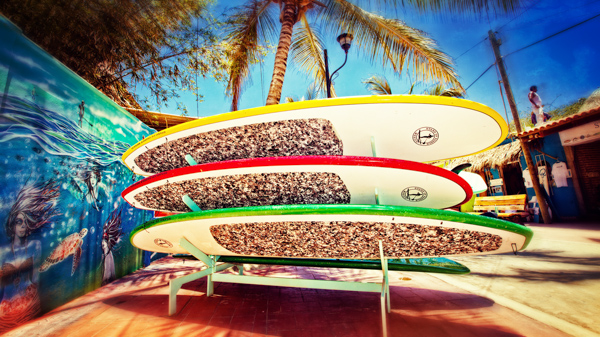
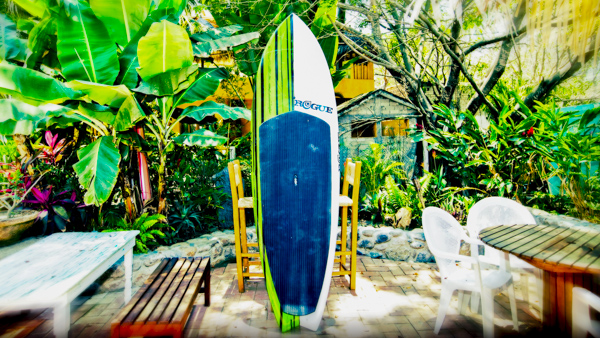
These racing models are specialized, designed for speed; they are relatively unstable, and not a good option for beginners or those who simply want to do some cruising out there.
At the other end of the spectrum are short, custom-made or off the shelf, wave-riding paddleboards, designed for competitive paddleboard surfing and/or general all-around shredding. These are the SUP equivalent of short surfboards, thrusters and the like. They come in all shapes and sizes, and can be made from epoxy or wood or foam and fiberglass, in all sorts of combinations. The fin set-ups range from single fin through three, four or even five fins (or, in the case of local paddler and soft shoe wave dancer Ryan Helm, zero fins), in various configurations. Serious competitive SUP surfers usually employ custom-made boards for contests, but there are countless varieties of mass-produced SUPs that are great for surfers of all levels. Seven feet sounds like a fairly short paddleboard, at least to me, but when the board is made of lightweight epoxy, and big on volume—thick and fat—the volume more than makes up for the instability inherent in the length, and makes them relatively easy to manage in the waves.
Transitioning from wave-riding boards to cruisers, you’ll find a huge range of options as far as size, shape, maneuverability, and everything else. These days, the holy grail of commercial, mass-produced paddleboarding is a board that is easy to use in the surf, easy to paddle long distances, and easy to carry. Getting all three of these things right is not easy, but there are plenty of boards in the 8 to 10 foot range that can almost do it all.
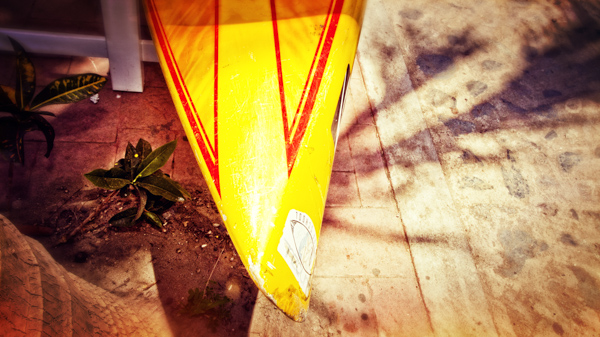
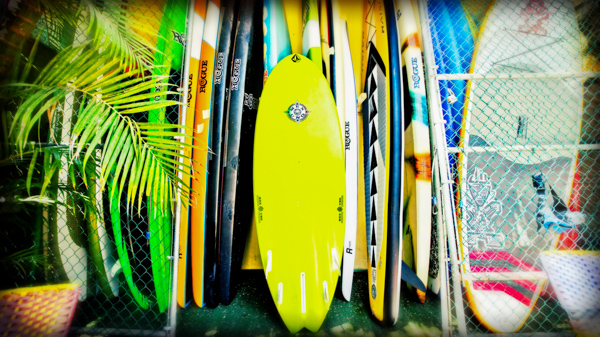
Beyond those hybrid, crossover, call them what you wills, are the cruisers, designed for flat water, for “touring,” for doing yoga while floating on the sea, for fishing while paddling, for heading out to a deserted beach with a waterproof backpack containing a picnic lunch and a bottle of wine. These big boards are what you’ll rent on the beach the first time you paddle; they are easy to learn on, easy to paddle, and loads of fun. You’ll find them available for rent at every surf shop and stand in Sayulita. Most of them will work in waves, especially small ones.
Recently several well-regarded board manufacturers have introduced inflatable models of almost every style of board. These boards are not quite there for surfing—the stress of pounding waves is just too much for an inflated board—but there are now a number of cruisers and even racing paddleboards that can be carried in a backpack and inflated on site. This makes for cheaper travel, obviously, since a backpack is just another piece of luggage, while as we have all learned of late, taking surfboards or paddleboards on airplanes has gotten painfully expensive.
There are also a number of paddle options out there. Longer paddles are better for distance paddling, shorter paddles for the kind of sprint paddling one does when catching waves. Carbon is the lightweight material of choice for the best paddles, although there are still plenty of fiberglass models out there. The handle shape that seems to be emerging as the most popular is a simple “T” form, sloped to accommodate the wrist and hand. There are paddles specifically designed for racing, surfing, cruising; for women, men, kids; for heavier and lighter people. The basic, informal test of a paddle’s appropriate length, if you are going to use it for all activities, is to stand straight up with the paddle at your side. If you reach up, your wrist should be on top, so that your hand hangs over.
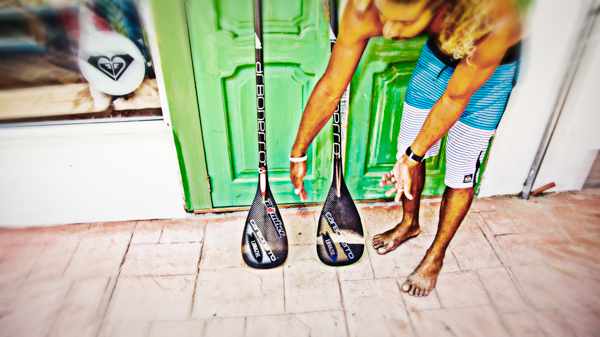
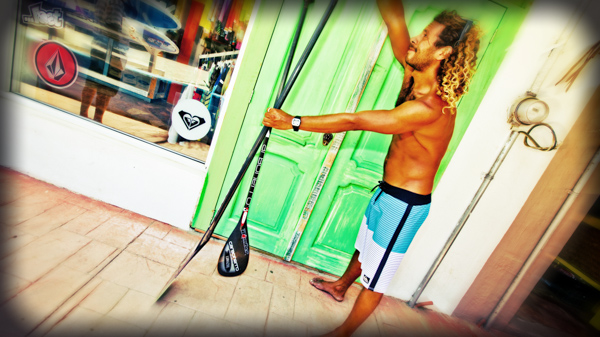
When you look out to sea at almost any destination beach in the world these days, you’ll see stand-up paddlers. It is hard to believe this sport is scarcely a decade old, if that. On the other hand, SUP’s popularity is completely understandable: here we have a fun sport that is easy to learn (the basics at least), that offers a great work-out (if you paddle correctly), and that can be done anywhere there is water, with or without waves, warm or cold, ocean, lake, or river. Go rent a board and give it a try.
Thanks to Hector Papas Gonzalez and Lunazul Surf Shop in Sayulita, and also to also to Toño Valdez and Christian Rodriguez from Stand Up Paddle Mexico, a paddle board shop in Sayulita. These guys know their stuff, and both shops sell and rent a great array of paddleboards and surfboards, and offer lessons in both sports.


